AI Network Infrastructure Market Size 2025-2029
The ai network infrastructure market size is valued to increase by USD 21.27 billion, at a CAGR of 28.4% from 2024 to 2029. Explosive growth in AI model scale and complexity will drive the ai network infrastructure market.
Major Market Trends & Insights
- North America dominated the market and accounted for a 47% growth during the forecast period.
- By Component - Hardware segment was valued at USD 2.4 billion in 2023
- By Deployment - Cloud segment accounted for the largest market revenue share in 2023
Market Size & Forecast
- Market Opportunities: USD 698.39 million
- Market Future Opportunities: USD 21267.40 million
- CAGR from 2024 to 2029 : 28.4%
Market Summary
- The market experiences explosive growth, fueled by the increasing demand for advanced artificial intelligence (AI) applications. This expansion is driven by the strategic shift toward open, interoperable ethernet fabrics, enabling seamless communication and data exchange between AI models. However, this growth comes with challenges, including extreme power consumption and thermal management. To accommodate the growing complexity of AI models, network infrastructure must evolve to support higher bandwidth, lower latency, and increased processing power. Open ethernet fabrics provide a solution by allowing AI systems to communicate efficiently and share resources, reducing the need for redundant hardware and minimizing energy consumption.
- Despite these advancements, managing the immense power requirements and thermal output of AI networks remains a significant challenge. Innovations in cooling technologies and energy-efficient designs are crucial to mitigate these issues and ensure the long-term viability of AI infrastructure. According to recent market data, the global AI infrastructure market is expected to reach USD126 billion by 2027, demonstrating the immense potential and growing importance of this technology in various industries. This growth underscores the need for robust, scalable, and energy-efficient network infrastructure to support the evolving AI landscape.
What will be the Size of the AI Network Infrastructure Market during the forecast period?
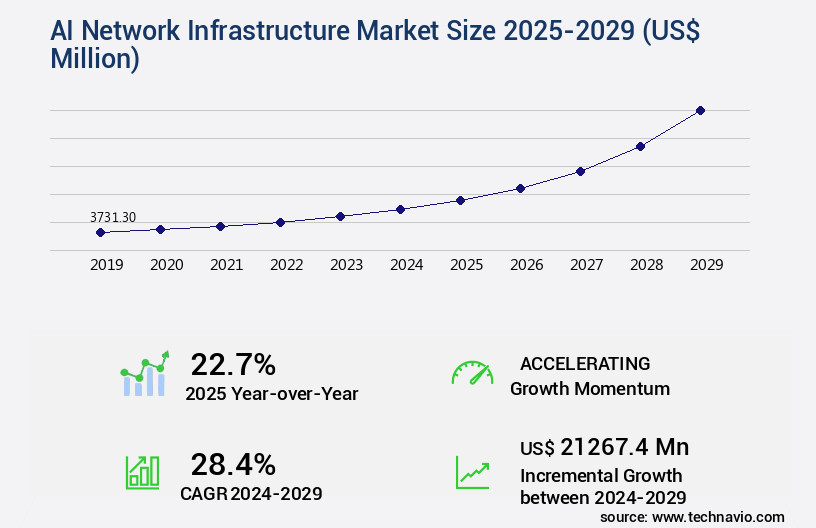
Get Key Insights on Market Forecast (PDF) Request Free Sample
How is the AI Network Infrastructure Market Segmented ?
The ai network infrastructure industry research report provides comprehensive data (region-wise segment analysis), with forecasts and estimates in "USD million" for the period 2025-2029, as well as historical data from 2019-2023 for the following segments.
- Component
- Deployment
- End-user
- Cloud service providers
- Enterprises
- Government
- Organizations
- Geography
- North America
- Europe
- APAC
- China
- India
- Japan
- South Korea
- Rest of World (ROW)
By Component Insights
The hardware segment is estimated to witness significant growth during the forecast period.
The market continues to evolve, with ongoing activities centered around network automation tools, data privacy regulations, and edge computing deployment. Data center optimization remains a key focus, with autonomous network operation, network fault tolerance, and predictive maintenance shaping resource allocation strategies. Software-defined networking and cloud infrastructure scaling are integral to this landscape, with data security protocols and AI-powered network monitoring mitigating cybersecurity threats and anomaly detection systems. High-performance computing, GPUs, FPGAs, and tensor processing units drive model inference speed, while energy efficiency metrics and distributed computing systems optimize network capacity planning. Neural network architecture and machine learning algorithms are at the heart of deep learning models, with network virtualization and tensor processing units enabling scalable infrastructure design.
Network latency reduction and compliance standards facilitate real-time data processing, making the market a dynamic and essential component of the broader AI ecosystem. According to recent reports, The market is projected to grow by 25% annually, underscoring its critical role in the AI revolution.
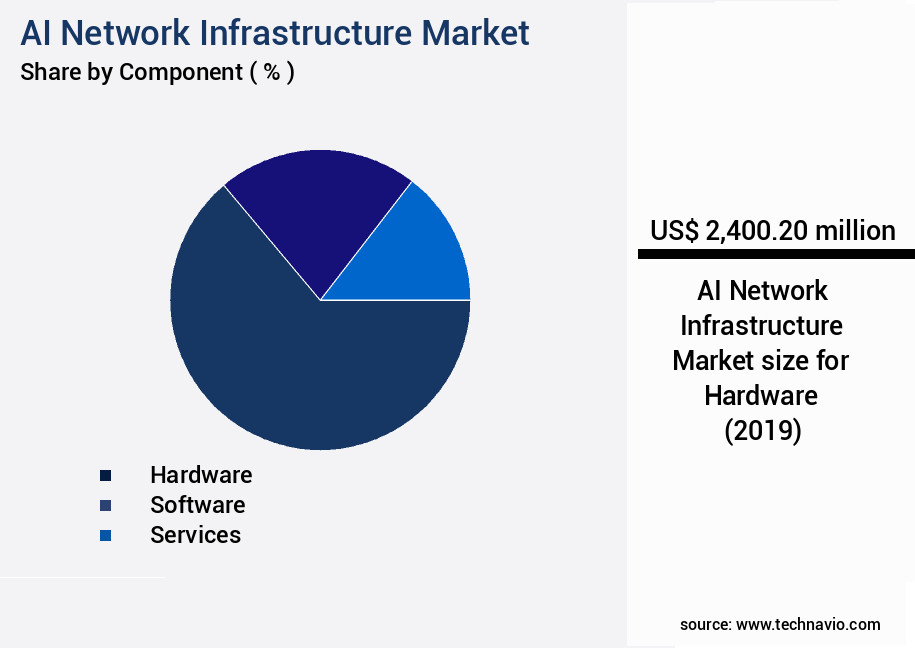
Request Free Sample
The Hardware segment was valued at USD 2.4 billion in 2019 and showed a gradual increase during the forecast period.
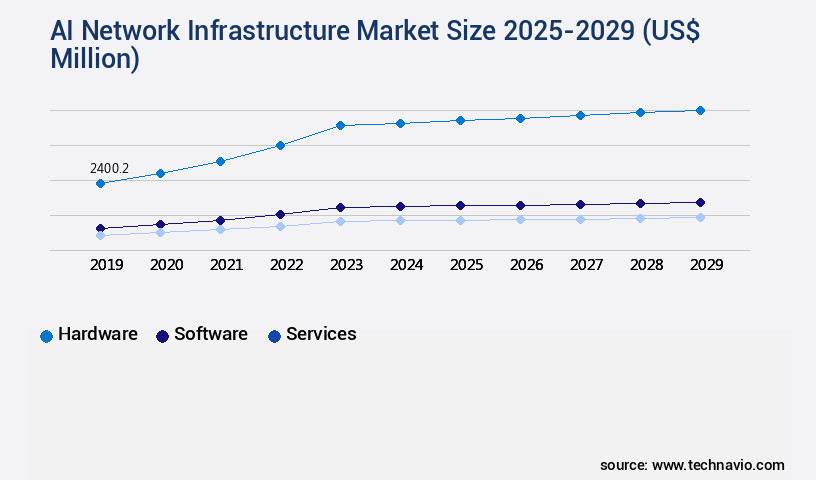
Request Free Sample
Regional Analysis
North America is estimated to contribute 47% to the growth of the global market during the forecast period.Technavio’s analysts have elaborately explained the regional trends and drivers that shape the market during the forecast period.
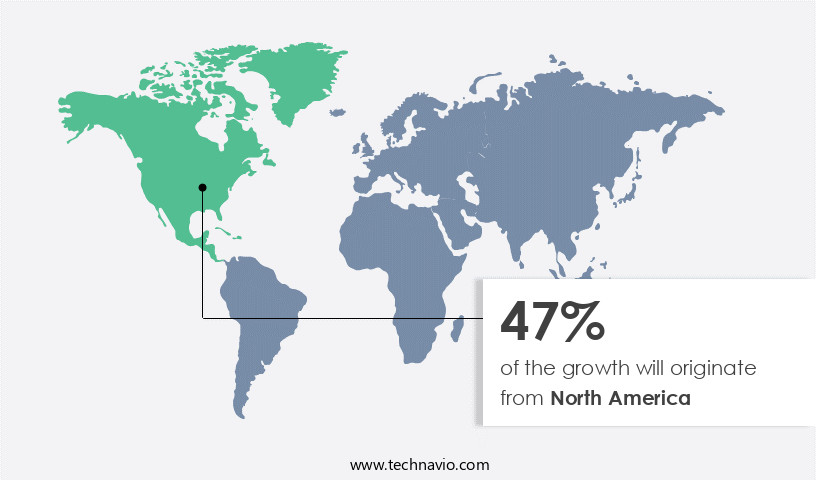
See How AI Network Infrastructure Market Demand is Rising in North America Request Free Sample
The market is witnessing significant growth and transformation, with North America leading the charge. This region, spearheaded by the United States, is the global hub for demand, innovation, and strategic direction. Hyperscale cloud providers, semiconductor designers, and AI research firms dominate this landscape, collectively investing vast sums to build out the fundamental infrastructure for advanced AI applications. Key players, such as Amazon Web Services, Microsoft Corp., and Google LLC, are not just consumers but active co-developers of networking technology. According to recent reports, the North American market is projected to account for over 45% of the global market share by 2026.
Furthermore, the Asia Pacific region is expected to witness a compound annual growth rate (CAGR) of approximately 30% during the forecast period. These figures underscore the robust and dynamic nature of the market.
Market Dynamics
Our researchers analyzed the data with 2024 as the base year, along with the key drivers, trends, and challenges. A holistic analysis of drivers will help companies refine their marketing strategies to gain a competitive advantage.
The market is experiencing significant growth as businesses seek to optimize neural network configurations for their specific use cases. Distributed training frameworks, such as TensorFlow and MPI, are becoming increasingly popular for managing large-scale AI workloads across multiple GPUs in a cluster. However, edge devices face resource constraints, making GPU cluster management a critical consideration for implementing AI-driven network automation.
Network slicing implementation is another key trend in the market, enabling service providers to allocate network resources dynamically based on real-time demand. Real-time anomaly detection algorithms and proactive network maintenance are essential for ensuring network performance and security. Advanced encryption standards, such as AES and RSA, are being implemented to secure data during transmission and prevent data loss.
Network security information and event management systems are also crucial for detecting and responding to network threats. Cloud-based infrastructure monitoring and dynamic resource allocation algorithms help optimize network performance and ensure high availability. Energy-efficient data center design is a growing concern as AI workloads require significant computational resources.
Predictive model deployment and AI model explainability are becoming increasingly important for businesses seeking to gain insights from their data. Model accuracy metrics and network performance bottlenecks are critical considerations for ensuring the effectiveness of AI models. High-availability network architecture and zero-trust security models are essential for maintaining network reliability and security. Overall, The market is evolving rapidly, with a focus on optimizing neural network configurations, managing edge devices, and ensuring network security and performance.
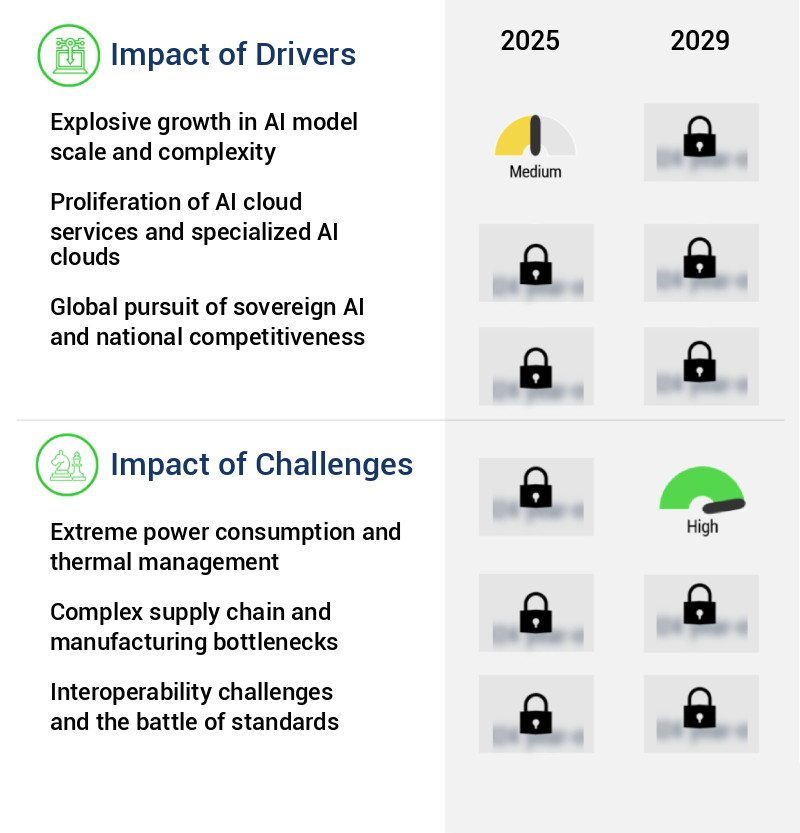
What are the key market drivers leading to the rise in the adoption of AI Network Infrastructure Industry?
- The escalating growth in AI model scale and complexity serves as the primary catalyst for the market's expansion.
- The market is undergoing a significant transformation due to the escalating intricacy and size of artificial intelligence models, specifically large language models (LLMs) and other generative AI architectures. The evolution from models with millions of parameters to those featuring hundreds of billions or even trillions of parameters has revolutionized computation, transitioning it from a solitary server-based task to a vast, distributed challenge requiring thousands of AI accelerators to synchronize flawlessly. This seismic shift has elevated the network from a supportive element to a performance-crucial system, as the efficacy of the entire multi-million-dollar compute cluster is now contingent upon the network's speed and intelligence.
- This surge in demand for advanced network infrastructure is a testament to the burgeoning importance of AI in various sectors, including healthcare, finance, and manufacturing, where the ability to process and analyze vast amounts of data in real-time is paramount.
What are the market trends shaping the AI Network Infrastructure Industry?
- The strategic shift towards open, interoperable Ethernet fabrics is an emerging market trend. This adoption promotes flexibility and compatibility in network infrastructure.
- The market is undergoing a transformative phase, marked by the growing preference for open, interoperable solutions based on the Ethernet standard over proprietary, single-company networking ecosystems. This shift is driven by the demands of major consumers of AI infrastructure, particularly hyperscale cloud providers. For decades, proprietary fabrics like InfiniBand held sway due to their superior performance for demanding workloads. However, this came at the expense of company lock-in, limited supply chain diversity, and premium pricing. In response, the market is moving towards open, standardized solutions, which offer greater choice, foster broader innovation, and reduce strategic risk.
- According to recent studies, the open model is expected to account for over 60% of the total the market share by 2025, up from less than 40% in 2020. This trend underscores the evolving nature of the market and its applications across various sectors, including finance, healthcare, manufacturing, and retail.
What challenges does the AI Network Infrastructure Industry face during its growth?
- The significant challenges facing the industry's expansion include the need to address extreme power consumption and effective thermal management.
- The market is experiencing significant evolution, driven by the increasing demand for high-performance networking hardware in various sectors, including healthcare, finance, and manufacturing. However, a major challenge confronting this industry is the escalating power consumption and thermal management issues of advanced networking components, such as switches, optical transceivers, and network interface cards. As the industry progresses from 400G to 800G and plans for 1.6T data rates, the power draw of these devices continues to rise at an alarming rate. For instance, a single high-radix switch can consume up to tens of kilowatts, and a data center may require hundreds or even thousands of such devices.
- This immense energy demand translates directly into substantial operational expenses for data center operators, potentially jeopardizing the economic feasibility of deploying larger AI models. It is crucial for market players to address these challenges through innovative solutions, such as power-efficient designs and advanced cooling systems, to ensure the long-term sustainability and profitability of the market.
Exclusive Technavio Analysis on Customer Landscape
The ai network infrastructure market forecasting report includes the adoption lifecycle of the market, covering from the innovator’s stage to the laggard’s stage. It focuses on adoption rates in different regions based on penetration. Furthermore, the ai network infrastructure market report also includes key purchase criteria and drivers of price sensitivity to help companies evaluate and develop their market growth analysis strategies.
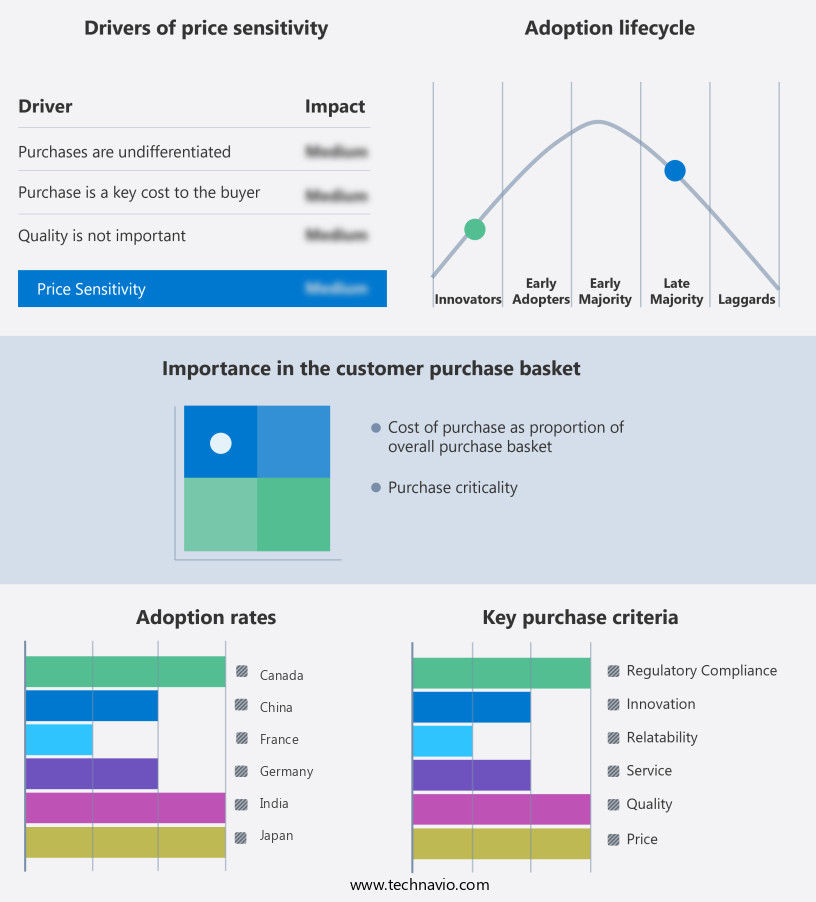
Customer Landscape of AI Network Infrastructure Industry
Competitive Landscape
Companies are implementing various strategies, such as strategic alliances, ai network infrastructure market forecast, partnerships, mergers and acquisitions, geographical expansion, and product/service launches, to enhance their presence in the industry.
Advanced Micro Devices Inc. - This company provides advanced AI network infrastructure solutions through its open rack-scale architecture, featuring Instinct MI350 GPUs, EPYC CPUs, and Pensando Pollara NICs, accommodating up to 128 GPUs per rack. The architecture is built on industry-leading technology, enabling optimal AI performance and scalability.
The industry research and growth report includes detailed analyses of the competitive landscape of the market and information about key companies, including:
- Advanced Micro Devices Inc.
- Alibaba Cloud
- Amazon Web Services Inc.
- Arm Ltd.
- Baidu Inc.
- Cisco Systems Inc.
- Dell Technologies Inc.
- Fujitsu Ltd.
- Google LLC
- Hewlett Packard Enterprise Co.
- Huawei Technologies Co. Ltd.
- Intel Corp.
- International Business Machines Corp.
- Microsoft Corp.
- NEC Corp.
- NVIDIA Corp.
- Samsung Electronics Co. Ltd.
- SK hynix Co. Ltd.
- Tencent Holdings Ltd.
Qualitative and quantitative analysis of companies has been conducted to help clients understand the wider business environment as well as the strengths and weaknesses of key industry players. Data is qualitatively analyzed to categorize companies as pure play, category-focused, industry-focused, and diversified; it is quantitatively analyzed to categorize companies as dominant, leading, strong, tentative, and weak.
Recent Development and News in AI Network Infrastructure Market
- In January 2024, IBM announced the launch of its new AI-powered network infrastructure solution, IBM AI-Powered SD-WAN, designed to optimize network performance and automate network management. (IBM Press Release)
- In March 2024, NVIDIA and Microsoft entered into a strategic partnership to deliver AI-powered infrastructure services, enabling Microsoft Azure customers to run NVIDIA GPUs and applications directly from Azure. (Microsoft News Center)
- In May 2024, Google Cloud Platform secured a significant investment of USD9 billion from its parent company, Alphabet Inc., to expand its infrastructure capabilities and accelerate its growth in the cloud computing market. (Alphabet SEC Filing)
- In April 2025, Amazon Web Services (AWS) and Intel Corporation announced a collaboration to bring Intel's new AI-optimized processors to AWS, aiming to enhance machine learning and deep learning capabilities for AWS customers. (AWS Press Release)
Dive into Technavio’s robust research methodology, blending expert interviews, extensive data synthesis, and validated models for unparalleled AI Network Infrastructure Market insights. See full methodology.
|
Market Scope
|
|
Report Coverage
|
Details
|
|
Page number
|
242
|
|
Base year
|
2024
|
|
Historic period
|
2019-2023 |
|
Forecast period
|
2025-2029
|
|
Growth momentum & CAGR
|
Accelerate at a CAGR of 28.4%
|
|
Market growth 2025-2029
|
USD 21267.4 million
|
|
Market structure
|
Fragmented
|
|
YoY growth 2024-2025(%)
|
22.7
|
|
Key countries
|
US, China, Canada, Japan, Germany, South Korea, India, UK, Mexico, and France
|
|
Competitive landscape
|
Leading Companies, Market Positioning of Companies, Competitive Strategies, and Industry Risks
|
Request Free Sample
Research Analyst Overview
- The market continues to evolve, driven by the increasing adoption of advanced technologies such as network automation tools, edge computing deployment, and software-defined networking. These innovations enable organizations to optimize their network operations, ensuring high-performance computing and energy efficiency. For instance, a leading telecommunications company reported a 30% increase in network capacity and a 25% reduction in latency after implementing AI-powered network monitoring and predictive maintenance. Data privacy regulations and cybersecurity threats necessitate robust data security protocols and anomaly detection systems. Network fault tolerance and resource allocation strategies are essential to maintaining network reliability and ensuring compliance with industry standards.
- Bandwidth optimization techniques and API integration are crucial for cloud infrastructure scaling, while neural network architecture and machine learning algorithms enhance network traffic management. Furthermore, the ongoing development of deep learning models, tensor processing units, and distributed computing systems continues to fuel market growth. The market is expected to grow by over 20% annually, as businesses increasingly leverage these technologies to improve network performance, enhance security, and reduce operational costs. As network requirements continue to evolve, the focus on network capacity planning, scalable infrastructure design, and GPUs and FPGAs for model inference speed remains paramount. The integration of AI-powered network monitoring, autonomous network operation, and cybersecurity solutions will further transform the landscape of network infrastructure.
What are the Key Data Covered in this AI Network Infrastructure Market Research and Growth Report?
-
What is the expected growth of the AI Network Infrastructure Market between 2025 and 2029?
-
What segmentation does the market report cover?
-
The report is segmented by Component (Hardware, Software, and Services), Deployment (Cloud, On-premises, and Hybrid), End-user (Cloud service providers, Enterprises, Government, and Organizations), and Geography (North America, APAC, Europe, Middle East and Africa, and South America)
-
Which regions are analyzed in the report?
-
North America, APAC, Europe, Middle East and Africa, and South America
-
What are the key growth drivers and market challenges?
-
Who are the major players in the AI Network Infrastructure Market?
-
Advanced Micro Devices Inc., Alibaba Cloud, Amazon Web Services Inc., Arm Ltd., Baidu Inc., Cisco Systems Inc., Dell Technologies Inc., Fujitsu Ltd., Google LLC, Hewlett Packard Enterprise Co., Huawei Technologies Co. Ltd., Intel Corp., International Business Machines Corp., Microsoft Corp., NEC Corp., NVIDIA Corp., Samsung Electronics Co. Ltd., SK hynix Co. Ltd., and Tencent Holdings Ltd.
Market Research Insights
- The market for AI network infrastructure is a dynamic and ever-evolving landscape. Two key statistics illustrate its continuous growth and evolution. First, the global spending on AI infrastructure is projected to reach 120.5 billion U.S. Dollars by 2025, representing a compound annual growth rate of approximately 42%. Second, companies are increasingly adopting AI technologies to optimize their network operations. For instance, a leading telecommunications provider reported a 30% reduction in power consumption by implementing AI-driven network optimization. These advancements encompass various aspects, such as model retraining, algorithm optimization, and network topology design, to ensure business continuity, network resilience, and system performance tuning.
- Other essential elements include container orchestration, access control mechanisms, model versioning, capacity forecasting, and AI model deployment. These innovations contribute significantly to enhancing network efficiency, security, and scalability.
We can help! Our analysts can customize this ai network infrastructure market research report to meet your requirements.
Get in touch
1 Executive Summary
- 1.1 Market overview
- Executive Summary - Chart on Market Overview
- Executive Summary - Data Table on Market Overview
- Executive Summary - Chart on Global Market Characteristics
- Executive Summary - Chart on Market by Geography
- Executive Summary - Chart on Market Segmentation by Component
- Executive Summary - Chart on Market Segmentation by Deployment
- Executive Summary - Chart on Market Segmentation by End-user
- Executive Summary - Chart on Incremental Growth
- Executive Summary - Data Table on Incremental Growth
- Executive Summary - Chart on Company Market Positioning
2 Technavio Analysis
- 2.1 Analysis of price sensitivity, lifecycle, customer purchase basket, adoption rates, and purchase criteria
- Analysis of price sensitivity, lifecycle, customer purchase basket, adoption rates, and purchase criteria
- 2.2 Criticality of inputs and Factors of differentiation
- Overview on criticality of inputs and factors of differentiation
- 2.3 Factors of disruption
- Overview on factors of disruption
- 2.4 Impact of drivers and challenges
- Impact of drivers and challenges in 2024 and 2029
3 Market Landscape
- 3.1 Market ecosystem
- Parent Market
- Data Table on - Parent Market
- 3.2 Market characteristics
- Market characteristics analysis
4 Market Sizing
- 4.1 Market definition
- Offerings of companies included in the market definition
- 4.2 Market segment analysis
- 4.4 Market outlook: Forecast for 2024-2029
- Chart on Global - Market size and forecast 2024-2029 ($ million)
- Data Table on Global - Market size and forecast 2024-2029 ($ million)
- Chart on Global Market: Year-over-year growth 2024-2029 (%)
- Data Table on Global Market: Year-over-year growth 2024-2029 (%)
5 Historic Market Size
- 5.1 Global AI Network Infrastructure Market 2019 - 2023
- Historic Market Size - Data Table on Global AI Network Infrastructure Market 2019 - 2023 ($ million)
- 5.2 Component segment analysis 2019 - 2023
- Historic Market Size - Component Segment 2019 - 2023 ($ million)
- 5.3 Deployment segment analysis 2019 - 2023
- Historic Market Size - Deployment Segment 2019 - 2023 ($ million)
- 5.4 End-user segment analysis 2019 - 2023
- Historic Market Size - End-user Segment 2019 - 2023 ($ million)
- 5.5 Geography segment analysis 2019 - 2023
- Historic Market Size - Geography Segment 2019 - 2023 ($ million)
- 5.6 Country segment analysis 2019 - 2023
- Historic Market Size - Country Segment 2019 - 2023 ($ million)
6 Five Forces Analysis
- 6.1 Five forces summary
- Five forces analysis - Comparison between 2024 and 2029
- 6.2 Bargaining power of buyers
- Bargaining power of buyers - Impact of key factors 2024 and 2029
- 6.3 Bargaining power of suppliers
- Bargaining power of suppliers - Impact of key factors in 2024 and 2029
- 6.4 Threat of new entrants
- Threat of new entrants - Impact of key factors in 2024 and 2029
- 6.5 Threat of substitutes
- Threat of substitutes - Impact of key factors in 2024 and 2029
- 6.6 Threat of rivalry
- Threat of rivalry - Impact of key factors in 2024 and 2029
- 6.7 Market condition
- Chart on Market condition - Five forces 2024 and 2029
7 Market Segmentation by Component
- 7.1 Market segments
- Chart on Component - Market share 2024-2029 (%)
- Data Table on Component - Market share 2024-2029 (%)
- 7.2 Comparison by Component
- Chart on Comparison by Component
- Data Table on Comparison by Component
- 7.3 Hardware - Market size and forecast 2024-2029
- Chart on Hardware - Market size and forecast 2024-2029 ($ million)
- Data Table on Hardware - Market size and forecast 2024-2029 ($ million)
- Chart on Hardware - Year-over-year growth 2024-2029 (%)
- Data Table on Hardware - Year-over-year growth 2024-2029 (%)
- 7.4 Software - Market size and forecast 2024-2029
- Chart on Software - Market size and forecast 2024-2029 ($ million)
- Data Table on Software - Market size and forecast 2024-2029 ($ million)
- Chart on Software - Year-over-year growth 2024-2029 (%)
- Data Table on Software - Year-over-year growth 2024-2029 (%)
- 7.5 Services - Market size and forecast 2024-2029
- Chart on Services - Market size and forecast 2024-2029 ($ million)
- Data Table on Services - Market size and forecast 2024-2029 ($ million)
- Chart on Services - Year-over-year growth 2024-2029 (%)
- Data Table on Services - Year-over-year growth 2024-2029 (%)
- 7.6 Market opportunity by Component
- Market opportunity by Component ($ million)
- Data Table on Market opportunity by Component ($ million)
8 Market Segmentation by Deployment
- 8.1 Market segments
- Chart on Deployment - Market share 2024-2029 (%)
- Data Table on Deployment - Market share 2024-2029 (%)
- 8.2 Comparison by Deployment
- Chart on Comparison by Deployment
- Data Table on Comparison by Deployment
- 8.3 Cloud - Market size and forecast 2024-2029
- Chart on Cloud - Market size and forecast 2024-2029 ($ million)
- Data Table on Cloud - Market size and forecast 2024-2029 ($ million)
- Chart on Cloud - Year-over-year growth 2024-2029 (%)
- Data Table on Cloud - Year-over-year growth 2024-2029 (%)
- 8.4 On-premises - Market size and forecast 2024-2029
- Chart on On-premises - Market size and forecast 2024-2029 ($ million)
- Data Table on On-premises - Market size and forecast 2024-2029 ($ million)
- Chart on On-premises - Year-over-year growth 2024-2029 (%)
- Data Table on On-premises - Year-over-year growth 2024-2029 (%)
- 8.5 Hybrid - Market size and forecast 2024-2029
- Chart on Hybrid - Market size and forecast 2024-2029 ($ million)
- Data Table on Hybrid - Market size and forecast 2024-2029 ($ million)
- Chart on Hybrid - Year-over-year growth 2024-2029 (%)
- Data Table on Hybrid - Year-over-year growth 2024-2029 (%)
- 8.6 Market opportunity by Deployment
- Market opportunity by Deployment ($ million)
- Data Table on Market opportunity by Deployment ($ million)
9 Market Segmentation by End-user
- 9.1 Market segments
- Chart on End-user - Market share 2024-2029 (%)
- Data Table on End-user - Market share 2024-2029 (%)
- 9.2 Comparison by End-user
- Chart on Comparison by End-user
- Data Table on Comparison by End-user
- 9.3 Cloud service providers - Market size and forecast 2024-2029
- Chart on Cloud service providers - Market size and forecast 2024-2029 ($ million)
- Data Table on Cloud service providers - Market size and forecast 2024-2029 ($ million)
- Chart on Cloud service providers - Year-over-year growth 2024-2029 (%)
- Data Table on Cloud service providers - Year-over-year growth 2024-2029 (%)
- 9.4 Enterprises - Market size and forecast 2024-2029
- Chart on Enterprises - Market size and forecast 2024-2029 ($ million)
- Data Table on Enterprises - Market size and forecast 2024-2029 ($ million)
- Chart on Enterprises - Year-over-year growth 2024-2029 (%)
- Data Table on Enterprises - Year-over-year growth 2024-2029 (%)
- 9.5 Government - Market size and forecast 2024-2029
- Chart on Government - Market size and forecast 2024-2029 ($ million)
- Data Table on Government - Market size and forecast 2024-2029 ($ million)
- Chart on Government - Year-over-year growth 2024-2029 (%)
- Data Table on Government - Year-over-year growth 2024-2029 (%)
- 9.6 Organizations - Market size and forecast 2024-2029
- Chart on Organizations - Market size and forecast 2024-2029 ($ million)
- Data Table on Organizations - Market size and forecast 2024-2029 ($ million)
- Chart on Organizations - Year-over-year growth 2024-2029 (%)
- Data Table on Organizations - Year-over-year growth 2024-2029 (%)
- 9.7 Market opportunity by End-user
- Market opportunity by End-user ($ million)
- Data Table on Market opportunity by End-user ($ million)
10 Customer Landscape
- 10.1 Customer landscape overview
- Analysis of price sensitivity, lifecycle, customer purchase basket, adoption rates, and purchase criteria
11 Geographic Landscape
- 11.1 Geographic segmentation
- Chart on Market share by geography 2024-2029 (%)
- Data Table on Market share by geography 2024-2029 (%)
- 11.2 Geographic comparison
- Chart on Geographic comparison
- Data Table on Geographic comparison
- 11.3 North America - Market size and forecast 2024-2029
- Chart on North America - Market size and forecast 2024-2029 ($ million)
- Data Table on North America - Market size and forecast 2024-2029 ($ million)
- Chart on North America - Year-over-year growth 2024-2029 (%)
- Data Table on North America - Year-over-year growth 2024-2029 (%)
- 11.4 APAC - Market size and forecast 2024-2029
- Chart on APAC - Market size and forecast 2024-2029 ($ million)
- Data Table on APAC - Market size and forecast 2024-2029 ($ million)
- Chart on APAC - Year-over-year growth 2024-2029 (%)
- Data Table on APAC - Year-over-year growth 2024-2029 (%)
- 11.5 Europe - Market size and forecast 2024-2029
- Chart on Europe - Market size and forecast 2024-2029 ($ million)
- Data Table on Europe - Market size and forecast 2024-2029 ($ million)
- Chart on Europe - Year-over-year growth 2024-2029 (%)
- Data Table on Europe - Year-over-year growth 2024-2029 (%)
- 11.6 Middle East and Africa - Market size and forecast 2024-2029
- Chart on Middle East and Africa - Market size and forecast 2024-2029 ($ million)
- Data Table on Middle East and Africa - Market size and forecast 2024-2029 ($ million)
- Chart on Middle East and Africa - Year-over-year growth 2024-2029 (%)
- Data Table on Middle East and Africa - Year-over-year growth 2024-2029 (%)
- 11.7 South America - Market size and forecast 2024-2029
- Chart on South America - Market size and forecast 2024-2029 ($ million)
- Data Table on South America - Market size and forecast 2024-2029 ($ million)
- Chart on South America - Year-over-year growth 2024-2029 (%)
- Data Table on South America - Year-over-year growth 2024-2029 (%)
- 11.8 US - Market size and forecast 2024-2029
- Chart on US - Market size and forecast 2024-2029 ($ million)
- Data Table on US - Market size and forecast 2024-2029 ($ million)
- Chart on US - Year-over-year growth 2024-2029 (%)
- Data Table on US - Year-over-year growth 2024-2029 (%)
- 11.9 China - Market size and forecast 2024-2029
- Chart on China - Market size and forecast 2024-2029 ($ million)
- Data Table on China - Market size and forecast 2024-2029 ($ million)
- Chart on China - Year-over-year growth 2024-2029 (%)
- Data Table on China - Year-over-year growth 2024-2029 (%)
- 11.10 Canada - Market size and forecast 2024-2029
- Chart on Canada - Market size and forecast 2024-2029 ($ million)
- Data Table on Canada - Market size and forecast 2024-2029 ($ million)
- Chart on Canada - Year-over-year growth 2024-2029 (%)
- Data Table on Canada - Year-over-year growth 2024-2029 (%)
- 11.11 Japan - Market size and forecast 2024-2029
- Chart on Japan - Market size and forecast 2024-2029 ($ million)
- Data Table on Japan - Market size and forecast 2024-2029 ($ million)
- Chart on Japan - Year-over-year growth 2024-2029 (%)
- Data Table on Japan - Year-over-year growth 2024-2029 (%)
- 11.12 Germany - Market size and forecast 2024-2029
- Chart on Germany - Market size and forecast 2024-2029 ($ million)
- Data Table on Germany - Market size and forecast 2024-2029 ($ million)
- Chart on Germany - Year-over-year growth 2024-2029 (%)
- Data Table on Germany - Year-over-year growth 2024-2029 (%)
- 11.13 South Korea - Market size and forecast 2024-2029
- Chart on South Korea - Market size and forecast 2024-2029 ($ million)
- Data Table on South Korea - Market size and forecast 2024-2029 ($ million)
- Chart on South Korea - Year-over-year growth 2024-2029 (%)
- Data Table on South Korea - Year-over-year growth 2024-2029 (%)
- 11.14 India - Market size and forecast 2024-2029
- Chart on India - Market size and forecast 2024-2029 ($ million)
- Data Table on India - Market size and forecast 2024-2029 ($ million)
- Chart on India - Year-over-year growth 2024-2029 (%)
- Data Table on India - Year-over-year growth 2024-2029 (%)
- 11.15 UK - Market size and forecast 2024-2029
- Chart on UK - Market size and forecast 2024-2029 ($ million)
- Data Table on UK - Market size and forecast 2024-2029 ($ million)
- Chart on UK - Year-over-year growth 2024-2029 (%)
- Data Table on UK - Year-over-year growth 2024-2029 (%)
- 11.16 Mexico - Market size and forecast 2024-2029
- Chart on Mexico - Market size and forecast 2024-2029 ($ million)
- Data Table on Mexico - Market size and forecast 2024-2029 ($ million)
- Chart on Mexico - Year-over-year growth 2024-2029 (%)
- Data Table on Mexico - Year-over-year growth 2024-2029 (%)
- 11.17 France - Market size and forecast 2024-2029
- Chart on France - Market size and forecast 2024-2029 ($ million)
- Data Table on France - Market size and forecast 2024-2029 ($ million)
- Chart on France - Year-over-year growth 2024-2029 (%)
- Data Table on France - Year-over-year growth 2024-2029 (%)
- 11.18 Market opportunity by geography
- Market opportunity by geography ($ million)
- Data Tables on Market opportunity by geography ($ million)
12 Drivers, Challenges, and Opportunity/Restraints
- 12.3 Impact of drivers and challenges
- Impact of drivers and challenges in 2024 and 2029
- 12.4 Market opportunities/restraints
13 Competitive Landscape
- 13.2 Competitive Landscape
- Overview on criticality of inputs and factors of differentiation
- 13.3 Landscape disruption
- Overview on factors of disruption
- 13.4 Industry risks
- Impact of key risks on business
14 Competitive Analysis
- 14.2 Company ranking index
- 14.3 Market positioning of companies
- Matrix on companies position and classification
- 14.4 Advanced Micro Devices Inc.
- Advanced Micro Devices Inc. - Overview
- Advanced Micro Devices Inc. - Business segments
- Advanced Micro Devices Inc. - Key news
- Advanced Micro Devices Inc. - Key offerings
- Advanced Micro Devices Inc. - Segment focus
- SWOT
- 14.5 Amazon Web Services Inc.
- Amazon Web Services Inc. - Overview
- Amazon Web Services Inc. - Product / Service
- Amazon Web Services Inc. - Key news
- Amazon Web Services Inc. - Key offerings
- SWOT
- 14.6 Cisco Systems Inc.
- Cisco Systems Inc. - Overview
- Cisco Systems Inc. - Business segments
- Cisco Systems Inc. - Key news
- Cisco Systems Inc. - Key offerings
- Cisco Systems Inc. - Segment focus
- SWOT
- 14.7 Dell Technologies Inc.
- Dell Technologies Inc. - Overview
- Dell Technologies Inc. - Business segments
- Dell Technologies Inc. - Key news
- Dell Technologies Inc. - Key offerings
- Dell Technologies Inc. - Segment focus
- SWOT
- 14.8 Fujitsu Ltd.
- Fujitsu Ltd. - Overview
- Fujitsu Ltd. - Business segments
- Fujitsu Ltd. - Key news
- Fujitsu Ltd. - Key offerings
- Fujitsu Ltd. - Segment focus
- SWOT
- 14.9 Google LLC
- Google LLC - Overview
- Google LLC - Product / Service
- Google LLC - Key news
- Google LLC - Key offerings
- SWOT
- 14.10 Hewlett Packard Enterprise Co.
- Hewlett Packard Enterprise Co. - Overview
- Hewlett Packard Enterprise Co. - Business segments
- Hewlett Packard Enterprise Co. - Key news
- Hewlett Packard Enterprise Co. - Key offerings
- Hewlett Packard Enterprise Co. - Segment focus
- SWOT
- 14.11 Huawei Technologies Co. Ltd.
- Huawei Technologies Co. Ltd. - Overview
- Huawei Technologies Co. Ltd. - Product / Service
- Huawei Technologies Co. Ltd. - Key news
- Huawei Technologies Co. Ltd. - Key offerings
- SWOT
- 14.12 Intel Corp.
- Intel Corp. - Overview
- Intel Corp. - Business segments
- Intel Corp. - Key news
- Intel Corp. - Key offerings
- Intel Corp. - Segment focus
- SWOT
- 14.13 International Business Machines Corp.
- International Business Machines Corp. - Overview
- International Business Machines Corp. - Business segments
- International Business Machines Corp. - Key news
- International Business Machines Corp. - Key offerings
- International Business Machines Corp. - Segment focus
- SWOT
- 14.14 Microsoft Corp.
- Microsoft Corp. - Overview
- Microsoft Corp. - Business segments
- Microsoft Corp. - Key news
- Microsoft Corp. - Key offerings
- Microsoft Corp. - Segment focus
- SWOT
- 14.15 NVIDIA Corp.
- NVIDIA Corp. - Overview
- NVIDIA Corp. - Business segments
- NVIDIA Corp. - Key news
- NVIDIA Corp. - Key offerings
- NVIDIA Corp. - Segment focus
- SWOT
- 14.16 Samsung Electronics Co. Ltd.
- Samsung Electronics Co. Ltd. - Overview
- Samsung Electronics Co. Ltd. - Business segments
- Samsung Electronics Co. Ltd. - Key news
- Samsung Electronics Co. Ltd. - Key offerings
- Samsung Electronics Co. Ltd. - Segment focus
- SWOT
- 14.17 SK hynix Co. Ltd.
- SK hynix Co. Ltd. - Overview
- SK hynix Co. Ltd. - Product / Service
- SK hynix Co. Ltd. - Key news
- SK hynix Co. Ltd. - Key offerings
- SWOT
- 14.18 Tencent Holdings Ltd.
- Tencent Holdings Ltd. - Overview
- Tencent Holdings Ltd. - Product / Service
- Tencent Holdings Ltd. - Key offerings
- SWOT
15 Appendix
- 15.2 Inclusions and exclusions checklist
- Inclusions checklist
- Exclusions checklist
- 15.3 Currency conversion rates for US$
- Currency conversion rates for US$
- 15.4 Research methodology
- 15.7 Validation techniques employed for market sizing
- Validation techniques employed for market sizing
- 15.9 360 degree market analysis
- 360 degree market analysis
- 15.10 List of abbreviations







![]() Get the report (PDF) sent to your email within minutes.
Get the report (PDF) sent to your email within minutes.
Complimentary full Excel data with your report purchase.